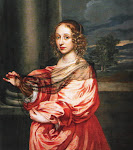

~
'I think I am destined to be the object of the folly of madmen' Marie de Rohan 1600-1679






 I'm intrigued.
I'm intrigued.
 This beautiful little girl is the Infanta Margarita of Spain, (August 12 1651 to March 12 1673) neice of Anne of Austria, Queen of France.
This beautiful little girl is the Infanta Margarita of Spain, (August 12 1651 to March 12 1673) neice of Anne of Austria, Queen of France.


 I've just found one of those little nuggets of information that delight and educate in equal measure.
I've just found one of those little nuggets of information that delight and educate in equal measure.
Bye, bye internal editor!

Violets were a major strewing herb and well-known for their use in cookery. These plants contain a chemical that , after the initial blast of scent, numbs the sense of smell. It makes them ethereal, like fairies at the bottom of the garden.
~

...is thought to be the original Parma Violet.
~

Rosa Mundi is one of the oldest named roses and it was named after The Fair Rosamund - Rosamund Clifford, mistress to Henry II. Her tombstone at Godstow Priory in Oxfordshire is inscribed...
Hic jacet in tomba rosa mundi, non rosa munda
~
Another purchase is Reine des Violettes
 A Bourbon Hybrid of divine colour (Purple/Lilac) and fragrance (True Old Rose.)
A Bourbon Hybrid of divine colour (Purple/Lilac) and fragrance (True Old Rose.) Bourbons came from a natural crossing of The China Rose with The Damask on the French Isle de Bourbon in 1817.
~
Also Cottage Maid


Rene d'Anjou
~

I was over-the-moon-delighted to find out that Catherine Delors author of Mistress of the Revolution has nominated this site for an Excessively Diverting Blog Award.
Many thanks Catherine.
In my turn I must nominate other sites who match the following criteria...
'The aim of the Excessively Diverting Blog Award is to acknowledge writing excellence in the spirit of Jane Austen’s genius in amusing and delighting readers with her irony, humor, wit, and talent for keen observation. Recipients will uphold the highest standards in the art of the sparkling banter, witty repartee, and gentle reprove. This award was created by the blogging team of Jane Austen Today to acknowledge superior writing over the Internet and promote Jane Austen’s brilliance.'
So, in no particular order ~
1. Bill Marshall's Dorothy Dunnett Blog for keeping the flame alive.
2.Tyra's Garden for beauty above and beyond the call.
3.Jane Brocket for writing my favourite Non-Fiction book of last year, The Gentle Art of Domesticity.
4.Cat Bauer for all things Venetian, especially The Venetian Vampire post.
5. Hoydens and Firebrands for all things 17th C - towards which I'm a tad biased!
6.DeluxeTapestries for so much information on this fascinating art form
7. A Twist of Rotten Silk for 17th century Scotland and the sheer enjoyment of reading Lor's blog.
Thank you all for giving and sharing so much :o)




 François VI, prince de Marsillac, later duc de La Rochefoucauld was born on September 15th 1613 in Paris. A soldier, courtier and latterly, a writer of those famous maxims, François was influenced by three great women – Marie de Rohan, Duchesse de Chevreuse – Anne of Austria – Anne Genevieve de Bourbon-Condé, Duchess de Longueville.
François VI, prince de Marsillac, later duc de La Rochefoucauld was born on September 15th 1613 in Paris. A soldier, courtier and latterly, a writer of those famous maxims, François was influenced by three great women – Marie de Rohan, Duchesse de Chevreuse – Anne of Austria – Anne Genevieve de Bourbon-Condé, Duchess de Longueville.Many months ago I wrote a note to myself in my workbook....
'Today we are looking at these events through the lens of history.
At the time they were just normal people with normal emotions, living their lives.
Narrow the view.
Forget what happened later.
At any given time the characters were the centre of their own world.
Make them intensely human.'
A quick look at Dictionary.com for the word FICTION gives....
1.
the class of literature comprising works of imaginative narration, esp. in prose form.
2.
works of this class, as novels or short stories: detective fiction.
3.
something feigned, invented, or imagined; a made-up story: We've all heard the fiction of her being in delicate health.
4.
the act of feigning, inventing, or imagining.
5.
an imaginary thing or event, postulated for the purposes of argument or explanation.
Imaginary or not. Market forces or not...
Fundamentally --- Historical fiction is for people and about people.
And I for one love it!
